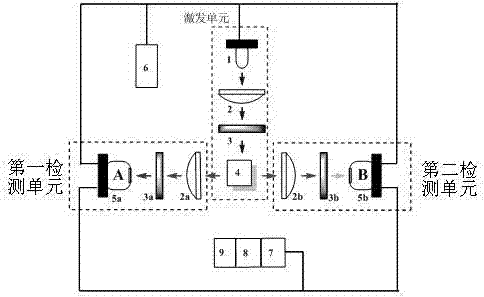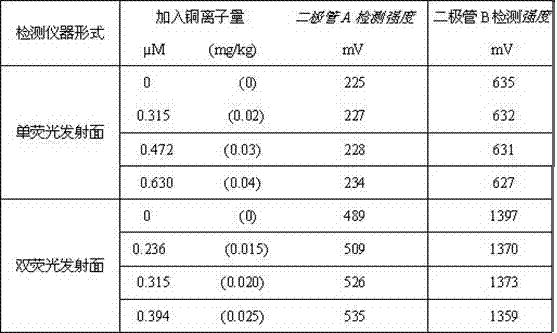Trace substance detector with two fluorescence emission surfaces, and detection method
A technology of emission surface and double fluorescence, which is applied in the direction of fluorescence/phosphorescence, instruments, measuring devices, etc., can solve the problems of weakening the fluorescence intensity of the incident photodiode, difficulty in meeting the detection requirements of trace substances, loss of fluorescence intensity, etc., and achieve low detection The effect of extreme, high sensitivity, and less loss of fluorescence
- Summary
- Abstract
- Description
- Claims
- Application Information
AI Technical Summary
Problems solved by technology
Method used
Image
Examples
Embodiment 1
[0027] Example 1: Fluorescence intensity of a dual-band detector with single fluorescence emission surface and dual single fluorescence emission surface
[0028] The experimental conditions of the dual-band detector with single fluorescence emission surface: copper ion fluorescence probe (10 µM, compound 1 in Chinese invention patent ZL200410082745.3, maximum excitation wavelength 450 nm, probe emission 525 nm wavelength fluorescence, probe and Copper ions are combined to emit 475 nm wavelength fluorescence, LED excitation light source (wavelength 450 nm, rated power 40 mW), excitation power supply 40 mW, 50 mM HEPES buffered water-ethanol solution (pH 7.4, 30 o C), copper ion concentration (10 µM), square standard cuvette, various fluorescent condenser lenses, dichroic mirror (500 nm), A-channel fluorescence filter (475 nm, narrow band filter), B-channel Fluorescence filter (525 nm, band pass filter), condenser lens (plano-convex lens), magnification 4 M.
[0029] The experimental...
Embodiment 2
[0033] Example 2: Detection limit of copper ions detected by dual-band detector with single or dual fluorescence emission surfaces
[0034] The experimental conditions were the same as in Example 1.
[0035] Experimental results:
[0036]
[0037] The above results show that when the copper fluorescent probe is detected by an optical system with a single fluorescent emission surface, when the copper content drops from 0.03 mg / kg to 0.02 mg / kg, the fluorescence intensity of the A and B channels only changes by 1 mV, which is less than the photoelectric The sensitivity error range of the diode, therefore, the detection limit of this optical system is 0.03 mg / kg; when the copper fluorescent probe is detected by the optical system of the patented dual fluorescence emission surface, the copper content is increased from 0.015 mg / kg When the value reaches 0.020 mg / kg, the fluorescence intensity of the A and B channels changes by 7-9 mV, which is still within the sensitive range of the phot...
Embodiment 3
[0039] Such as figure 1 The working process of the detector shown is: the light emitted by the excitation light source 1 is irradiated to the cuvette 4 through the condenser lens 2 and the filter 3, and the detection fluorescent probe and the reference internal standard fluorescent dye in the cuvette are simultaneously Excited to emit fluorescence of different wavelengths; the fluorescence emitted by the detection fluorescent probe is converted into an electrical signal by the first photodiode 5a through the first fluorescence condenser lens 2a and the first fluorescence filter 3a in the first detection unit; The fluorescence emitted by the reference internal standard fluorescent dye is converted into an electrical signal by the second fluorescent photodiode 5b through the second fluorescent condenser lens 2b and the second fluorescent filter 3b in the second detection unit; in the two detections A and B The electrical signal obtained by the unit is amplified by the data acquis...
PUM
 Login to View More
Login to View More Abstract
Description
Claims
Application Information
 Login to View More
Login to View More - R&D
- Intellectual Property
- Life Sciences
- Materials
- Tech Scout
- Unparalleled Data Quality
- Higher Quality Content
- 60% Fewer Hallucinations
Browse by: Latest US Patents, China's latest patents, Technical Efficacy Thesaurus, Application Domain, Technology Topic, Popular Technical Reports.
© 2025 PatSnap. All rights reserved.Legal|Privacy policy|Modern Slavery Act Transparency Statement|Sitemap|About US| Contact US: help@patsnap.com



